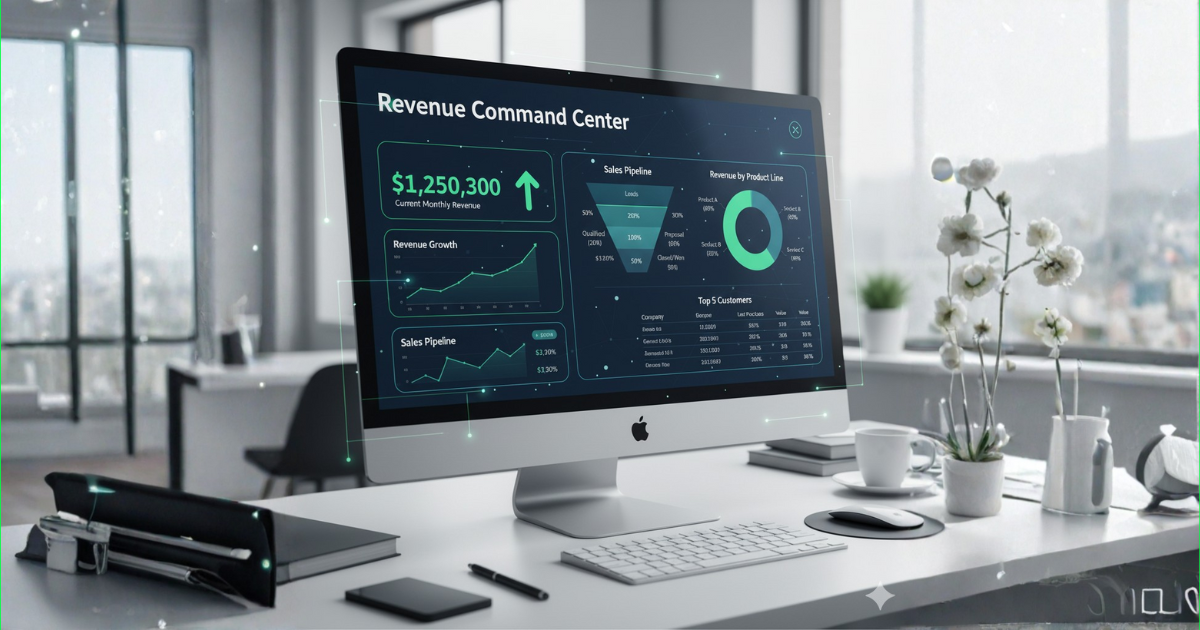Read Time: 8 min
You know your business needs a system. The question is: what makes a system complete?
Most business owners buy pieces. A CRM here. A marketing tool there. An automation platform somewhere else. Each piece works fine alone. Together, they create chaos.
A complete revenue system has four dimensions working together: Strategy, Process, Technology, and Data. Miss one, and you're building on sand. Get all four right, and revenue becomes predictable.
Key Takeaways
-
Complete systems need all four dimensions, not just tools. Strategy without process fails. Technology without data wastes money.
-
Each dimension connects to the others, creating multiplied results. Weak links break the whole chain.
-
Professional businesses engineer systems systematically, layer by layer. Amateurs chase the next shiny tool.
Dimension 1: Strategy
Strategy tells you what to do and when to do it. Without strategy, you're guessing. With strategy, you're executing a proven plan.
Think of strategy as the blueprint for your revenue machine. It documents exactly how you find customers, nurture them, book meetings, close deals, and keep them coming back. Every step mapped. Every decision made before you need to make it.
Strategy playbooks contain your proven sequences. Cold outreach patterns that convert at 11.3% (Markster customer average, Q2 2025) instead of industry average 1.8%. Nurture sequences that move prospects from awareness to decision in 34 days instead of 127. Meeting booking flows that fill your calendar while you sleep.
These aren't theory documents. They're working instructions built from real results across hundreds of businesses. A cold outreach playbook maps find, personalize, engage. A nurture sequence playbook structures educate, build trust, convert. A meeting booking playbook defines qualify, schedule, confirm.
Professional services businesses under $2M typically run 5 to 12 core playbooks. Each one answers the same question: what exactly do we do in this situation? The playbook gives the answer. Your team executes it. Results stack up.
Strategy solves the amateur problem: random acts of marketing that produce random results. One month you try LinkedIn ads. Next month cold email. Then referrals. Then partnerships. Nothing runs long enough to measure. Nothing builds on previous work. Every quarter starts from zero.
Pros document what converts, replicate it across accounts, and measure outcomes against baseline. When cold email converts at 8.7%, you run more cold email. When webinars convert at 2.1%, you kill webinars and reallocate budget to what works.
Strategy creates the foundation for systematic growth. Each playbook becomes a reusable asset. Train new team members faster. Scale without chaos. Maintain quality as you grow.
The difference: amateurs hustle harder when results slow down. Professionals check the playbook, identify the broken step, fix it, and move forward. One burns out. The other grows faster.
Dimension 2: Process
Process connects your strategy to daily execution. It's the assembly line that turns playbooks into actual revenue, not documents gathering dust in a shared drive.
Process defines who does what, when they do it, and how it gets done. Without process, your strategy stays theoretical. With process, it becomes operational. Process answers: how does a lead move from cold to qualified? What triggers the next touchpoint? Who owns each handoff?
Consider the typical service business pipeline. Marketing generates a lead. Sales should follow up within 5 minutes. Why? Response within 5 minutes converts 9x better than response after 30 minutes (Markster analysis, 2025). But who ensures that happens? What system routes the lead? How do you track compliance?
Process builds the links between strategy and results. It standardizes the work so outcomes become predictable. When every lead gets the same treatment, you can measure what works. When treatment varies randomly, you're flying blind.
Professional process design has three layers. First, stage definitions with clear entry and exit criteria. "Qualified" means documented pain point, budget range, decision timeline, and authority confirmation. No documentation, no advancement. This eliminates fake deals clogging your pipeline where deals stall forever in fake stages.
Second, automated workflows that execute tasks without human memory. Lead comes in. System enriches data. Sequence triggers. Follow-ups happen. Meeting books. Notes log. CRM updates. Nothing waits on someone remembering to do it.
Third, time promises (operational SLAs) that create accountability. Inbound response under 5 minutes. Outbound follow-up within 24 hours. Meeting confirmation within 2 hours. Proposal delivery within 48 hours. Track compliance. Coach gaps. Repeat weekly.
Process eliminates the founder bottleneck. When process lives in your head, the business stops when you stop. When process lives in documented workflows, anyone can execute it. Revenue flows whether you're working or on vacation.
The typical B2B service firm wastes 30% of productive time on manual data entry (Markster customer data). Process design eliminates that waste. When lead routing happens automatically, enrichment runs on trigger, and CRM updates without manual entry, that 30% returns to actual selling.
Process creates consistency that strategy alone cannot deliver. Strategy says what to do. Process ensures it actually happens. Every time. The same way. At scale.
Dimension 3: Technology
Technology executes your process automatically. It's the engine that runs your playbooks without requiring humans to remember each step.
Technology consolidates your 5 to 12 disconnected tools into one unified platform. The command center provides complete visibility. Every prospect, every stage, every touchpoint lives in one place. Nothing falls through cracks because nothing lives in silos anymore.
Core modules include contact management that tracks every interaction. Pipeline visualization that shows deal flow in real time. Campaign automation across email, SMS, and social channels. Calendar coordination that books meetings automatically. Real-time analytics showing what drives results.
But here's what matters: integration. When your tools don't talk to each other, you become the integration layer. Lead comes in on website. You manually add to CRM. You manually create contact in email platform. You manually schedule follow-up. You manually log activity. You manually update deal stage. You manually generate report.
That's 60 to 80 hours per rep spent on manual updates during typical platform implementations. Technology eliminates that waste through integration. When prospect data enriches automatically, email sequences trigger based on behavior, meetings book via calendar sync, and activity logs without manual entry, friction disappears.
Professional technology stacks have four characteristics. First, one place for all customer information. Customer information lives in one place. Updates happen everywhere instantly. No duplicate records. No conflicting information. Single source of truth.
Second, workflow automation. When X happens, do Y automatically. Lead score hits threshold, route to sales. Email opens three times, trigger call sequence. Meeting books, send confirmation and prep materials. Deal closes, initiate onboarding. The system handles repetitive work so humans focus on relationship work.
Third, intelligent agents that execute specific tasks. The Finder identifies ideal prospects matching your profile. The Enricher gathers contact information. The Writer personalizes every message based on prospect signals. The Sender manages outreach timing. The Booker coordinates calendars and confirms appointments. The Tracker monitors engagement and reports results.
These aren't chatbots. They're specialized agents trained on conversion patterns and response data. One agent doesn't replace your team. The agent fleet handles prospecting, enrichment, follow-up, and scheduling so humans close deals.
Fourth, real-time visibility. Dashboards that show pipeline health, conversion rates at each stage, deal velocity, win rates by source, forecast accuracy, and team performance. Leaders see problems before they become crises. Reps see exactly where to focus effort.
Technology turns manual processes into systematic execution. Sales teams spend 4 to 5 hours weekly on manual forecasting and data entry. Automation recovers that time for actual selling. The math matters: 5 hours weekly times 50 weeks times $125 hourly equivalent equals $31,250 annual value per rep from time recovery alone.
Dimension 4: Data
Data connects all three other dimensions and makes them intelligent. Strategy without data is guessing. Process without data can't improve. Technology without data is expensive theater.
Data answers the questions that drive decisions. Which prospects convert at the highest rate? What messaging patterns generate response? Which sequences move deals fastest through pipeline? Where do deals stall? What signals predict churn? Which customers expand? Data tells you.
Professional data architecture has three layers. First, unified collection. Every interaction captured automatically. Email opens, link clicks, website visits, content downloads, meeting attendance, proposal views, contract negotiations. Nothing depends on manual logging because manual logging fails predictably.
Second, consistent definitions. What counts as a qualified lead? When does a deal move to negotiation stage? How do you calculate win rate? Everyone uses the same definitions. This eliminates the problem where marketing reports 500 qualified leads but sales says only 47 were actually qualified.
Third, actionable insights. Raw data means nothing. Analyzed data drives action. Dashboards showing pipeline coverage, stage conversion rates, deal velocity, win rate by segment, forecast accuracy, and rep performance turn numbers into decisions.
Data enables the feedback loop that creates systematic improvement. You run cold outreach campaigns. Data shows 11.3% response rate, 34% meeting booking rate, 28% close rate. Next campaign, you adjust one variable: messaging. Response rate jumps to 14.1%. You keep the new messaging. You adjust another variable: send timing. Response rate hits 16.7%. You keep that too.
This is how professionals achieve 11.3% response rates versus industry average 1.8% (Markster customer average, Q4 2024). Not magic. Systematic testing guided by data. Each test builds on previous results. Improvements multiply.
Data transforms revenue from art to science. Amateurs make decisions based on gut feel and recent memory. Professionals make decisions based on measured outcomes across the entire customer journey. One guesses. The other knows.
The four dimensions multiply. Strategy creates the plan. Process executes the plan. Technology automates the execution. Data makes execution intelligent and improving continuously. Together, they create a revenue system. Separately, they're just expensive pieces that don't solve the problem.
How the 4 Dimensions Work Together
The real power comes when all four dimensions connect. Each dimension amplifies the others. Each gap weakens the whole system.
Strategy defines what to do. Your cold outreach playbook says send personalized email to prospects matching ICP, follow up 3 times over 14 days, track response rate and meeting booking rate.
Process turns it into daily operations. Leads matching ICP route automatically to enrichment. Enriched leads trigger email sequence. Sequence sends message 1 on day 0, message 2 on day 3, message 3 on day 7, message 4 on day 14. Responses route to sales rep within 5 minutes. Meeting booking sends calendar invite and confirmation automatically.
Technology executes the process. AI worker finds prospects matching ICP criteria. Enrichment agent gathers contact information and company details like size, industry, and revenue. Writer agent personalizes each message based on prospect signals. Sender agent manages timing for optimal delivery. Calendar agent coordinates meeting booking and sends confirmations. CRM logs every interaction automatically.
Data makes it intelligent. Analytics show message 2 gets highest response rate at 18.3%. Message 1 only converts at 8.1%. You test swapping order. New sequence starts with high-performing message. Response rate jumps from 11.3% to 14.7%. Data guided the decision. Results improved systematically.
This is how one client generated $2.4M in pipeline in 47 days versus $1.1M in 90 days previously (Markster customer case study, anonymized). Same team. Same market. Different system. The complete four-dimension architecture created 218% velocity increase.
Building Your Complete System
You don't build all four dimensions simultaneously. You build systematically, layer by layer, letting each dimension inform the next.
Start with strategy. Document one core playbook in week 1 to 4. Layer in process in week 5 to 8. Add technology in week 9 to 12. Close with data in week 13 to 16. Sixteen weeks total (average across Markster implementations). One complete system for one revenue activity. Download the blueprint for detailed week-by-week guidance.
| Dimension | Amateur Approach | Professional Approach |
|---|---|---|
| Strategy | Random tactics, no documentation | Documented playbooks, proven sequences |
| Process | Inconsistent, depends on individuals | Standardized workflows, clear time promises |
| Technology | Disconnected tools, manual work | Integrated platform, automated execution |
| Data | Scattered reports, no insights | Unified dashboards, actionable intelligence |
| Results | Unpredictable, founder-dependent | Predictable, system-dependent |
The table shows the gap. Amateurs treat each dimension independently. Professionals engineer connections between dimensions. One produces random results. The other produces predictable revenue.
Your Next Step: Start With One Dimension
You don't need to fix everything today. You need to start with one dimension, done completely, for one revenue activity.
Pick your highest-value revenue activity. For most service businesses under $2M, that's either cold outreach or existing customer expansion. Choose one.
Start with strategy. Spend one week documenting exactly how you currently execute that activity. Write it down. Every step. Even the messy parts. Especially the messy parts. This becomes your baseline.
Week two, test your documented approach with your team. Does it work when someone else follows the instructions? Where do they get stuck? Where do they improvise? Update the documentation based on what you learn.
Week three, measure results. How many prospects contacted? How many responses? How many meetings? How many deals? Compare against previous random approach. Even a 20% improvement proves the concept.
Then layer in the next dimension. Take your proven playbook and turn it into daily operations. Build the workflows. Define the triggers. Establish the time promises. Make it systematic.
Complete systems beat incomplete systems every time. Four dimensions working together generate predictable revenue. Three dimensions create gaps. Two dimensions waste money. One dimension is just theory.
If you're working 70 hours weekly while revenue remains unpredictable, you don't have a motivation problem. You have an architecture problem. The business structure creates the outcome. Change the structure, change the outcome.
Systems scale. Heroes don't.
See how Markster systematizes this →
FAQs
Q: Which dimension should I build first?
A: Always start with strategy. Document what actually works before you try to turn it into operations or automate it. Process without strategy creates efficient execution of the wrong activities. Technology without strategy automates chaos. Data without strategy gives you numbers that don't inform decisions. Strategy first, then layer in the other three dimensions systematically.
Q: Can I use different technology for each dimension?
A: You can, but it creates integration problems that waste time and money. The typical service business uses 5 to 12 disconnected tools, spending 30% of productive time on manual data transfer (Markster customer data). Professional systems use integrated platforms where technology spans all four dimensions in one place. Less friction, better results, lower cost.
Q: How long does it take to build a complete four-dimension system?
A: For one core revenue activity, 16 weeks following the systematic approach outlined above (average across Markster implementations). Week 1 to 4 for strategy, week 5 to 8 for process, week 9 to 12 for technology, week 13 to 16 for data. After the first system is complete, each additional revenue activity takes 8 to 10 weeks (average across Markster implementations) because you understand the pattern and reuse infrastructure.




